|
|
|
| |
|
|
| |
Lawrence of Arabia |
|
| |
| |
| In
September 1930 T.E. Lawrence spent a holiday in Collieston
along with two companions. They lived in a cottage
at the edge of the harbour. This cottage can still
be seen although it has since been modernised and
extensively rebuilt. Whilst staying in the cottage
to his publisher, F.N. Doubleday, in which he describes
his life in the village and paints a colourful pen
portrait of the sea and the surrounding countryside.
|
| |
|
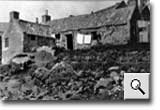
|
|
| |
|
|
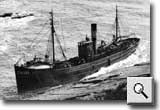 |
| Shipwreck |
| |
On 9th
April, 1931 the trawler Rightway went ashore on rocks
at Broadhaven, south of Collieston. The Collieston
Coastguard Company heard the sounding siren at 00.30
and reached the scene at 01.30. Three of the crew
were taken ashore by breeches buoy but the vessel
then slid off the rocks.
The seven remaining crew had to jump on to an island
rock where they were told to stay until they were
rescued. Cliff ladders were then used. One end of
a line was attached to the bottom of the ladder and
the other end was secured to the heaving cane which
was thrown over the rock to the stranded men.
Scrambling along the ladder onto rocks near the base
of the cliff, the crew were then assisted up the main
cliff face. The last man was brought to safety at
04.00 and the Company was dismissed at 06.30.
|
| |
|
|
| |
|
|
| |
Fishing |
|
| |
| |
Alexander
Ritchie mending a traditional wicker woven basket,
known as a murlin, circa 1935. Known to everyone as
‘Cottie’, Alexander Ritchie lived in the
High Town area of the village. His mother was a fishwife
who used to travel round the neighbouring farms selling
the fish caught by her husband or bartering them for
farm produce.
On one of her travels, during the latter stages of
pregnancy, the onset of labour pains forced the woman
to stop at Cotehill Farm, just over one mile north
of Collieston. She duly gave birth to a baby boy and
left him in the capable hands of the farmer’s
wife while she continued on her way to sell her wares,
collecting the new addition to the Ritchie family
on her way home.
The baby, christened Alexander, was appropriately
nicknamed ‘Cottie’ and answered to that
name for the remainder of his days. Alexander ‘Cottie’
Ritchie died, aged 76 years, on 22nd April, 1945.
|
|
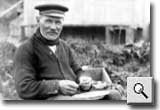 |
| |
|
|
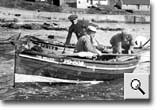 |
Some
of the village fishermen and their boats circa 1935.
The boat in the foreground, ‘The Nellies’,
was registered in Peterhead and had the registration
number PD602.
By the mid 1930’s line fishing was only carried
out in small boats. This was due to the build up of
sand on the foreshore, caused by the construction
of the Pier at the end of the 19th century, which
made it impossible for the bigger boats to come ashore.
In the background, above the Pier, is the area of
the village known as the Cliff and the cottage which
can be seen slightly right of centre is the one in
which T E Lawrence stayed in 1930. It has received
some care and attention and is now harled and white
washed. |
|
|
| |
| |
|
|
| |
|
|
| |
James
Walker who was known as ‘Jimmicky’. ‘Jimmicky’
was a fisherman who lived in the village and he is
seen here preparing his lines ready to shoot from
a wicker skull raised on a specially made work ‘bench’.
Behind ‘Jimmicky’ is a shed which has
been painted with layer upon layer of black Archangel
tar.
|
| |
|
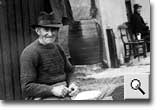 |
| |
|
|
| |
Holiday
Time |
|
| |
| |
The harbour
and beach circa 1935. Above the Pier, is the area
of the village known as the Cliff and the cottage
which can be seen slightly left of centre is the one
in which T E Lawrence stayed in 1930.
It has received some care and attention and is now
harled and white washed. By the mid 1930’s Collieston
was becoming a popular destination for holidaymakers
and day-trippers.
There is clear evidence that the foreshore is much
less rocky than it was at the beginning of the 20th
Century and the safe, sandy beach, which has gradually
formed over the years since the Pier was constructed
in 1894, is now a great attraction for residents and
tourists alike.
|
| |
|
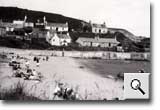 |
| |
|
|
| |
The
Coastguard |
|
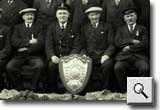 |
| |
The Collieston
Auxiliary Coastguard Company was awarded the Board
of Trade Shield in 1931 for saving the ten-man crew
of the Aberdeen trawler ‘Nairn’ after
it had gone aground in stormy seas on 2nd December
at Broadhaven one mile south of Collieston.
Bronze medals for gallantry in saving life at sea
were also awarded to District Officer Smailes, Coastguardsman
F Shelley and Messrs Walker, Henderson and Robertson.
It was a great occasion for so small a village and
the first time that the shield had been awarded to
Scotland. |
| |
|
|
| |
|
|
| |
The
Collieston Auxiliary Coastguard Company circa 1930.
The company of some 16 men makes its way back to the
village after a rocket practise on the cliffs near
the coastal path leading to Forvie. Hackley Head is
clearly visible in the background.
The Life Saving Apparatus being pulled was stored
in the ‘Rocket Shed’ at the top of Perthudden,
near Cluny Cottages, the former Coastguard Cottages.
|
| |
|
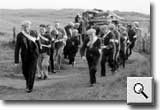 |
| |
|
|
 |
The
Collieston Auxiliary Coastguard Company is engaged
in ‘Rocket Practice’ circa 1930. During
the testing of the equipment, a line would be shot
from the top of the Quarry over to Cransdale.
This would enable the Company of sixteen men to practise
operating the breeches buoy, a vital piece of life-saving
apparatus and one frequently used during a rescue
operation. At the end of the 1940’s ‘Rocket
Practise’ was moved from Cransdale, to the cliff
top above the Peerman Braes on Forvie Moor where a
pole was erected.
Similar to a ship’s mast and known as the ‘Rocket
Pole’, it was in use until 1992 when the Company
was re-graded from a Company of sixteen men to an
Instant Response Team of four, who currently train
with their colleagues in nearby Cruden Bay. |
| |
|
|
| |
|
|
| |
A
Coast Guard life saving breeches buoy held by a young
woman. On either side of the woman stand two members
of the Collieston Coastguard Company while at the
rear is Charles Ingram, a resident of Cluny Cottages,
who was himself a member of the Collieston Auxiliary
Coastguard Company.
The Coastguard Company kept their life saving equipment
in the rescue apparatus store, known locally as ‘the
rocket shed’, at Cluny Cottages, which is where
the photograph was taken circa 1935.
|
| |
|
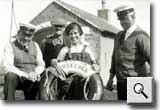 |
| |
|
|
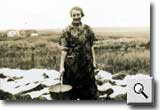 |
| The
Bleach Green |
| |
Margaret
Ingram bleaches her washing on the grass near the
Sand Loch, Collieston, circa 1930. In the days before
electricity was brought to some parts of Collieston
in 1954, it was common for women from the village
to carry their washing up to the Sand Loch where the
various items would be spread out over the grass at
the southern end of the loch, opposite the Free Church.
Margaret Kidd was born in 1867 and married Charles
Ingram in 1893. The couple spent most of their married
life in Collieston where they lived in various houses
in the village, Charles earning his living as a salmon
fisherman and Margaret a hard working wife and mother
to their eleven children.
Charles and Margaret moved to Cluny Cottages near
the Sand Loch, in the late 1920’s where they
lived until they both died in 1952.
|
| |
|
|
| |
|
|
| |
Education |
|
| |
| |
Mrs McLeod
and her class at Collieston School in 1932. The school,
which opened in 1877, closed in 1922 and the children
from the village had to travel some three miles to
the nearest school at Slains for their education.
Due to overcrowding at Slains School, Collieston School
was re-opened in 1932. It finally ceased to be a school
on July 1, 1949. The last Head Teacher was Gladys
Robertson.
The building is now used as the Collieston Community
Centre and many local organisations such as the Children’s
Playgroup, Over 60’s Club and Women’s
Rural Institute, meet in the Centre on a regular basis. |
| |
|
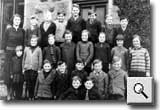 |
| |
|
|
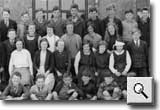 |
Pupils
of Slains Public School in 1937. Most of the children
who attended the school at this time came from families
who either worked on the farms in the Parish of Slains
or on the nearby Auchmacoy Estate with only a few
children from Collieston attending the school at this
time.
The population in Collieston had not yet recovered
from the exodus of families to Torry, Aberdeen, following
the decline in the fishing industry some thirty years
earlier. The fishing families still owned their houses
in the village but many of them were rented out or
lay empty for most of the year until they were used
by the families who came back to the village during
the summer months.
The school building, visible behind the group of children,
was subsequently demolished in 1968 and replaced by
a modern school building. Where the original school
building was situated has now been transformed into
a playground for the children.
|
| |
|
|
| |
|
|
| |
The
Interior of Slains Parish Church |
|
| |
| |
| The old
pipe organ in Slains Parish Church that Dr Lewis
Mackie refers to in his story about |
| |
|
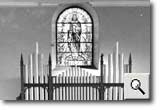 |
|
 |
|
| ....copyright
collieston's century 2003 |
|